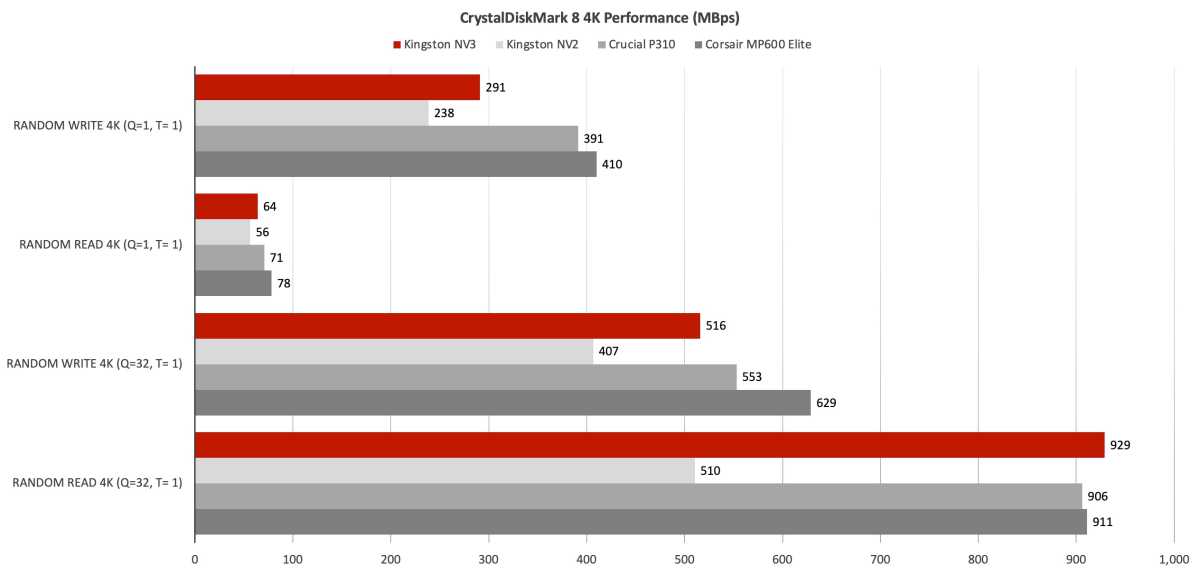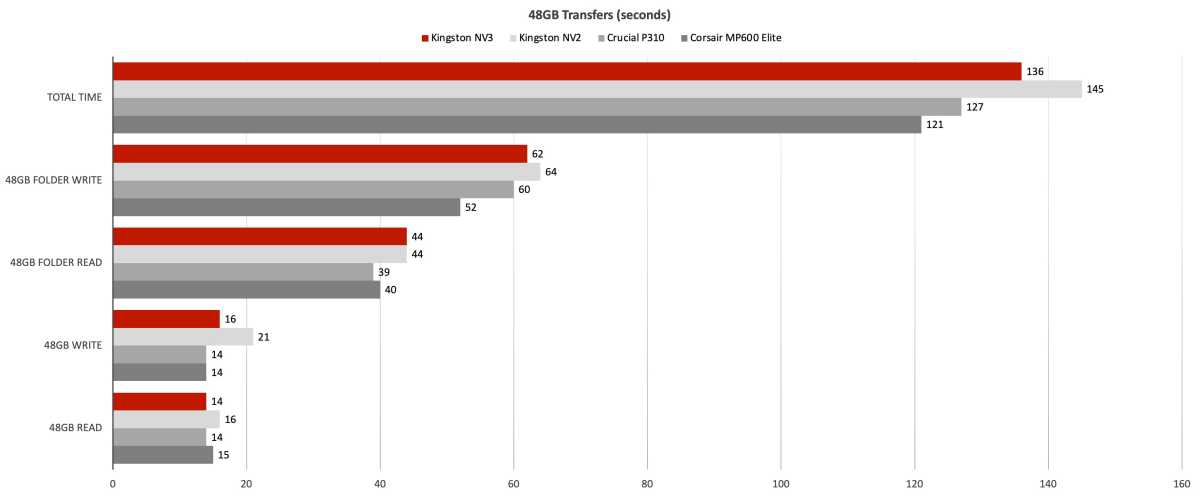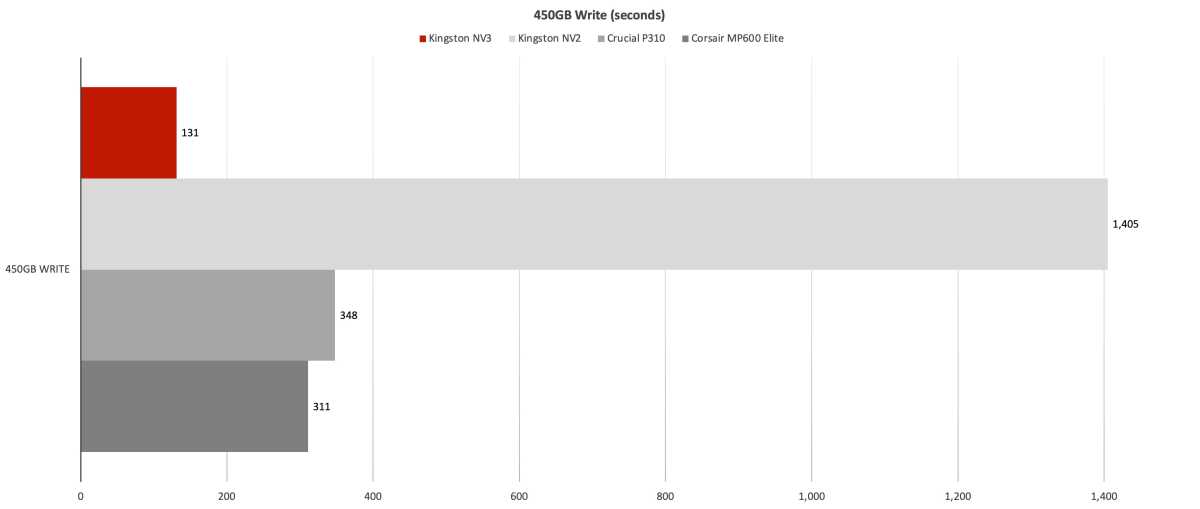 At a glance
At a glanceExpert's Rating
Pros
- Very fast real-world transfers
- Super affordable
Cons
- Parsimonious TBW rating
- Only 3-year warranty
- Slows to a crawl off cache
Our Verdict
If you’re looking for excellent performance without undue expenditure, then Kingston’s NV3 Gen 4 SSD is just what the doctor ordered.
Best Prices Today: Kingston NV3 NVMe SSD
Last year’s NV2 from Kingston delivered great bang-for-your-SSD-buck. This year’s NV3 is still wonderfully affordable, yet massively improved — even setting a record writing our 450GB single file. Who would’ve thought?
What are the Kingston NV3’s features?
The NV3 is a PCIe 4.0 x4 (four lane), M.2 NVMe SSD using a DRAM-less (Host Memory Buffer/HMB) design to cut down on costs. The controller is a Silicon Motion SM2268XG and the NAND is Kingston-labeled, stacked QLC. At least that’s my assumption given the performance off cache and TBW rating.
The actual type of NAND and the number of layers wasn’t specified by Kingston, and the company says that will vary from capacity to capacity.
Further reading: See our roundup of the best SSDs to learn about competing products.

How much does the Kingston NV3 cost?
The NV3 is available in 500GB/$54, 1TB/$77, 2TB/$154 (tested) flavors. A 4TB version is in the works, but not as of yet priced.
While the NV3 is very inexpensive, it might just cost you some peace of mind. The drive is warrantied for only three years, rather than the usual five. Additionally, the TBW (terabytes that my be written) rating is a miserly 160TBW per TB of NAND — well below the 250TBW per TB of NAND that was our previous low.
That previous low was for a QLC drive, hence our speculation that this is what the NV3 employs. For whatever reason, vendor outlooks aren’t nearly as sunny on the longevity of QLC as they are on that of TLC. Still, 160TB is a lot of writing for the average user.
How fast is the Kingston NV3?
While the synthetic benchmark results were a touch below average for a HMB design, the NV3’s real-world results were slightly better. Not to mention, a huge improvement over its NV2 predecessor.
The Crucial P310 and Corsair M600 Elite shown in the charts are both similarly performing 2TB PCIe 4.0 host memory buffer designs, though the former is a small form-factor 2230 (22mm wide, 30mm long).
While not rated the fastest of the three drives, the NV3’s CrystalDiskMark 8 sequential transfer performance is still quite good.

The NV3 also did amazingly well in random operations, though HMB SSDs are not on on par with DRAM designs in this regard.

The NV3 also did amazingly well in random operations, though not on on par with DRAM designs.
Jon L. Jacobi
While the NV3 was fast in our 48GB transfers, it didn’t set any records.

Where the NV3 did set a record was in writing our 450GB file. Sweet! Note that the NV2 was a 1TB SSD with considerably less secondary cache, as well as likely also employing QLC, hence the tragically long write time.

Once the generous secondary cache (approximately 600GB of the NAND written as SLC) on our 2TB test unit ran out during a subsequent 900GB file write, the NV3 also slowed dramatically — oscillating between 80MBps and 900MBps, mostly on the low side.

Note that as the drive fills, this slowdown will occur earlier during writes. However, when this occurred in our testing, the transfer rate seemed to stabilize at around 220MBps rather than oscillate.
This write slowdown will affect very few users, but pros constantly banging on their SSD might opt for a more consistent TLC design, not to mention one with a higher TBW rating.
Should you buy the Kingston NV3?
The NV3 will give you 98 percent of the top-shelf NVMe experience for a whole heck of a lot less cash. Unless you really intend to pound on your drive, it’s all most users need. This is a fantastic improvement over the NV2 and a good value.
This review was amended on August 31st, 2024 to correct and align the chart colors.
How we test
Drive tests currently utilize Windows 11, 64-bit running on an X790 (PCIe 4.0/5.0) motherboard/i5-12400 CPU combo with two Kingston Fury 32GB DDR5 4800MHz modules (64GB of memory total). Both 20Gbps USB and Thunderbolt 4 are integrated to the back panel and Intel CPU/GPU graphics are used. The 48GB transfer tests utilize an ImDisk RAM disk taking up 58GB of the 64GB of total memory. The 450GB file is transferred from a 2TB Samsung 990 Pro which also runs the OS.
Each test is performed on a newly formatted and TRIM’d drive so the results are optimal. Note that in normal use, as a drive fills up, performance may decrease due to less NAND for secondary caching, as well as other factors. This can be less of a factor with the current crop of SSDs with far faster late-generation NAND.
Caveat: The performance numbers shown apply only to the drive we were shipped and to the capacity tested. SSD performance can and will vary by capacity due to more or fewer chips to shotgun reads/writes across and the amount of NAND available for secondary caching. Vendors also occasionally swap components. If you ever notice a large discrepancy between the performance you experience and that which we report, by all means, let us know.





